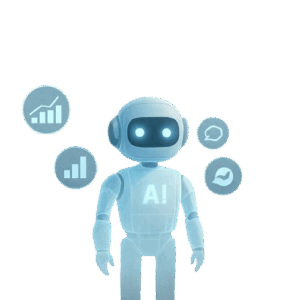Apply For Scholarship
In 2025, generative AI has evolved from being a trend to a necessity in the content marketing landscape. As brands seek to scale content production, personalize messaging, and maintain consistency across platforms, generative AI tools have become critical to every stage of content strategy from ideation and creation to optimization and distribution. For digital marketers and students aiming to future-proof their skillsets, understanding the synergy between generative AI and content strategy is now foundational.

Generative AI refers to tools that use machine learningespecially large language models (LLMs) to create original content. Whether it’s drafting a blog, generating ad copy,repurposing a whitepaper into social media snippets, or even creating short-form videos, AIis helping content teams produce more, faster. Platforms like ChatGPT, Jasper, Copy.ai, and Writer.com are capable of:
● Generating first drafts of articles in minutes
● Suggesting headlines, CTAs, and summaries
● Translating and localizing content
● Maintaining brand tone through style guidelines
With these capabilities, content professionals can redirect their focus from tedious writingtasks to higher-value work like ideation, creative direction, and strategic planning.

A content strategy isn’t just about churning out blog posts. It’s a structured plan that aligns content with business goals and customer needs. This includes deciding what to create, for whom, when, where, and why. Generative AI can dramatically improve the content planning process by:
● Analyzing content gaps through AI-driven audits
● Identifying SEO opportunities via trend analysis and keyword suggestions
● Mapping content to customer journeys using predictive models
● Generating content calendars and format recommendations based on audience behavior
For example, tools like MarketMuse analyze existing website content and recommend 1SEO-optimized topics. Similarly, ChatGPT can generate content matrices to organize what content exists, what’s missing, and how it aligns with each stage of the buyer’s journey.
Speed is a major advantage of using generative AI. What once took a team of writersseveral hours like producing a 1,000-word article can now be drafted in minutes using the right AI prompt. Generative AI helps scale content by:
● Creating multiple versions of the same message for different platforms
● Turning long-form content into carousels, email copy, or videos
● Translating content for global audiences
● Reducing bottlenecks in content production and approval AI video tools like Lumen5 and Synthesia also allow teams to convert blogs into dynamic videos, adding another layer of scalability for omnichannel strategies.
While AI brings speed and data-driven insights, humans add creativity, empathy, and contextual understanding elements machines can’t replicate. The best content teams of 2025 are not replacing humans with AI, but using AI to amplify human creativity. This collaborative model works because:
● Humans ensure emotional resonance and brand voice
● AI structures and accelerates output
● Editors review and refine content for accuracy and tone
● Ethics and context are governed by human oversight
The result? Content that’s not only fast and scalable, but also engaging, trustworthy, and brand-aligned.

Despite its advantages, generative AI isn’t without challenges. Over-reliance on AI tools can lead to issues such as factual inaccuracies, plagiarism, generic tone, or even bias in language. Therefore, responsible use is essential. Ethical content creation with AI involves:
● Always fact-checking outputs
● Avoiding blind automation for sensitive topics
● Disclosing AI-assisted content when appropriate
● Training teams on responsible usage
Many AI writing platforms now include fact-checking, tone control, and plagiarism detection features to support responsible usage but human validation remains non-negotiable.
Incorporating generative AI into your content strategy offers tangible benefits:
● Increased content volume with the same team size
● Lower outsourcing and production costs
● Faster response to market trends and opportunities
● Improved SEO performance through consistent publishing
● Enhanced personalization for different audience segments
These gains enable marketers to shift their focus from content execution to innovation,
experimentation, and high-level strategy.
For students and emerging digital marketers, here’s how to begin leveraging generative AI:
1. Start Small: Use free tools like ChatGPT for idea generation, outlines, or first drafts.
2. Define Goals: Know what you want AI to assist with be it speed, SEO, creativity, or repurposing.
3. Build Prompts Wisely: Learn to craft detailed prompts that guide the AI toward desired outcomes.
4. Combine with Human Oversight: Always edit, review, and refine AI-generated outputs.
5. Learn AI Tools: Explore platforms like Jasper, Copy.ai, MarketMuse, and Writer.com to understand their strengths.
Looking ahead, generative AI will be embedded into every layer of the content ecosystem—from SEO analysis and campaign planning to real-time content personalization. Tools will grow more intuitive, and marketing teams will become hybrid engines of creativity and automation. To thrive in this evolving landscape, digital marketers must:
● Stay current with AI innovations
● Develop AI literacy (prompt engineering, ethical use)
● Pair AI capabilities with strategic content thinking
● Embrace experimentation while safeguarding brand values

Generative AI is no longer a futuristic concept it’s a present-day partner reshaping content strategy and creation. When used responsibly and strategically, it doesn’t replace humans it elevates them. For digital marketers and students alike, now is the time to embrace this shift, learn the tools, and become fluent in AI-powered content workflows. The future of content isn’t AI vs. human it’s AI + human. Together, they form the ultimate
creative powerhouse.
Generative AI has become foundational in digital marketing, enabling creation of blogs, social media posts, ad copy, and more—quickly and at scale. By handling time-consuming drafting tasks, AI frees marketers to concentrate on creativity, strategy, and brand alignment
AI tools now seamlessly convert long-form content into social media captions, video scripts, visuals, and more—speeding up workflows and expanding format reach efficiently
Generative AI can “hallucinate,” producing confidently styled but inaccurate or misleading information. Deploying it in accuracy-sensitive contexts—like legal or compliance—is risky. For safer use, businesses are turning to private or hybrid AI systems combined with strong human oversight
GEO is the practice of structuring content—using clear headings, FAQ schema, concise sections, and trustworthy signals—so that AI systems like ChatGPT or Gemini can understand, summarize, and cite it effectively. This goes beyond traditional SEO to optimize for AI discovery and visibility
Generative AI boosts efficiency, allowing teams to publish more high-quality content with fewer resources. According to surveys, over 40% of marketers report significant improvements in both content creation and campaign efficiency
Asia’s Leading Digital Marketing & Data Science Institute
A comprehensive methodology with the best curriculum, designed according to current corporate demands and needs.
Copyright © NDMIT Edusoft Private Limited